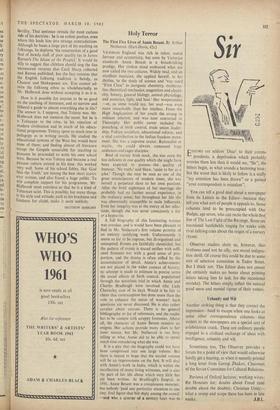Holy Terror
The First Five Lives of Annie Besant. By Arthur Nethercot. (Hart-Davis, 42s.)
VICTORIAN England was rich in talent, moral fervour and eccentricity, but even by Victorian standards Annie Besant is a breath-taking odigy. Her tireless mind embraced what are now called the two cultures. Widely read, and an excellent musician, she applied herself, in her thirties, to the study of science and 'was rated "First Class" in inorganic chemistry, mathema- tics, theoretical mechanics, magnetism and electri- city, botany, general biology, animal physiology, and acoustics, light, and heat.' Her temperament —or, as some would say, her soul—was even more remarkable than her intellect. From the High Anglicanism of her youth she swung ,o militant atheism, and was later converted to Theostiphy. Her public career included the preaching of birth control, trade union leader- ship, Fabian socialism, educational reform, and a vital contribution tO the Indian freedom move- ment. She was a supreme orator. Rationalist or mystic, she could always command huge audiences and eager disciples.
Bred of mainly Irish stock, she was none the less deficient in one quality which she might have been expected to possess—the quality of humour. 'No truth,' said Shaw, 'came to her as a joke.' Though she may be seen as one of the great emancipators of modern times, she was herself a perpetual slave to her own passions. After the brief nightmare of her marriage she probably had no further sexual experience, in the ordinary sense; but throughout her life she was abnormally susceptible to male influences. Even her integrity was at the mercy of her affec- tions, though she was never consciously a liar or a hypocrite.
A full biography of this fascinating woman was overdue, and it would have been pleasant to find in Mr. Nethercot's first volume promise of an entirely satisfying work. Unfortunately it seems so far to be copious, but ill-organised and uninspired. Events are faithfully chronicled, but the pattern of events is traced neither with suffi- cient firmness nor with a good sense of pro- portion, and the drama is often stifled by the accumulation of detail. Annie's achievements are not placed in the wider context of history; no attempt is made to estimate in precise terms the social effects of birth control, popularised through the notorious trial in which Annie and Charles Bradlaugh were involved (the Lady Chatterley case of its day). Would it be fair to claim that contraception has done more than the vote to enhance the status of women? Such questions are never discussed. He is also rather cavalier about sources. There is no general bibliography or list of references, and the reader has to be content with scrappy footnotes. Above all, the character of Annie Besant remains an enigma. Her actions provide many clues to her inner nature, but Mr. Nethercot is too busy telling us what Annie did to be able to spend much time considering what she was.
It is a pity that the biography could not have been compressed into one large volume. But there is reason to hope that the second volume will be an improvement on the first. It will deal with Annie's work in India, which is within the recollection of many living witnesses, and is also the part of her life about which very little has yet been written. At Bradlaugh's funeral. in 1891, Annie Besant was a conspicuous mourner, but nobody 'paid any particular attention to one tiny, frail figure that hid shyly among the crowd' —and who a quarter of a century later was to maintain (wrongly) that the British would give his country freedom in return for support in the war against Germany, while Annie Besant main- tained (rightly) that India must take advantage of Britain's hour of need to secure independence. The 'frail figure' was thought to be a surer guide than the restless white woman, with her flair for politics. So in a sense he was, though the Raj endured for another generation as a result of his misjudgment. His name was Gandhi.
ALTRINCHAM







































 Previous page
Previous page